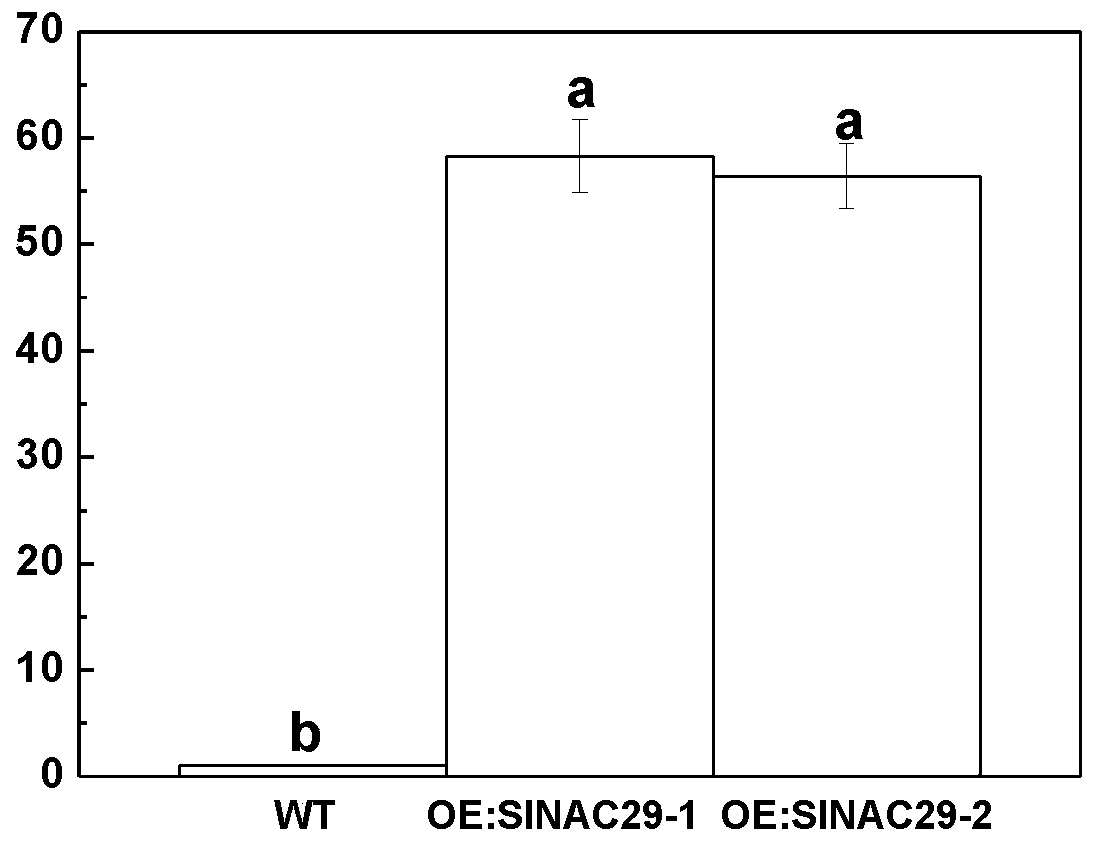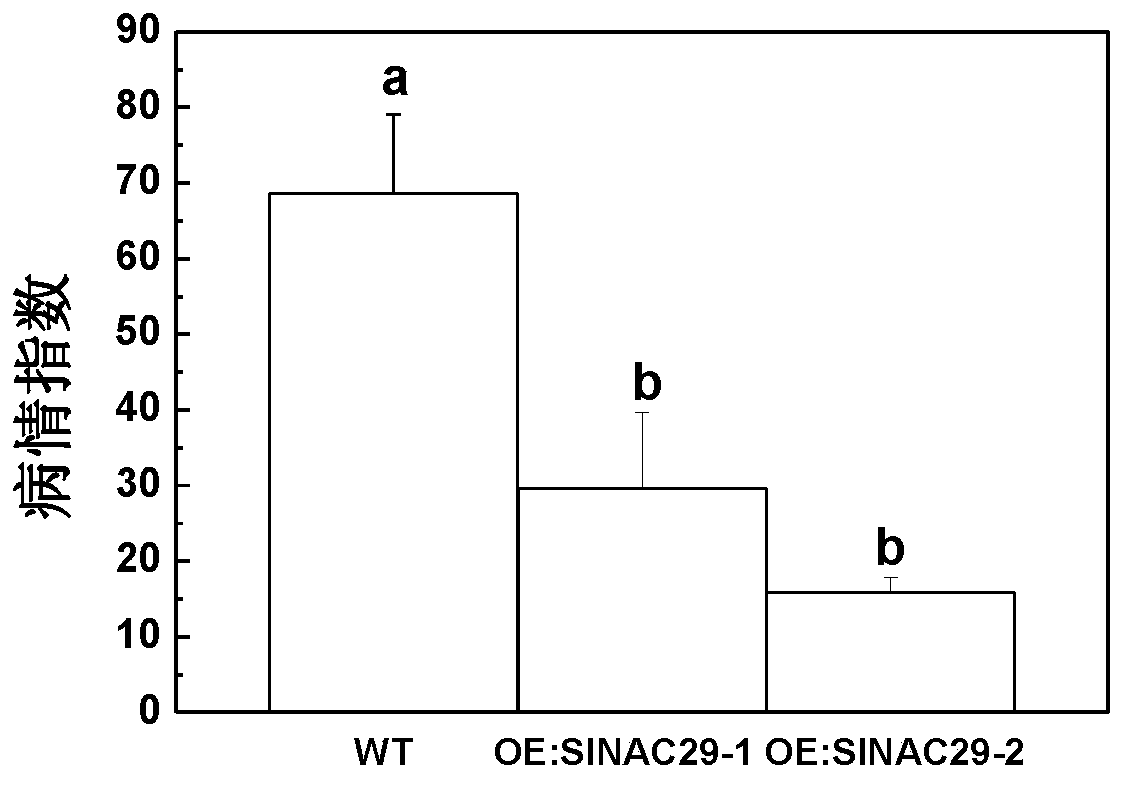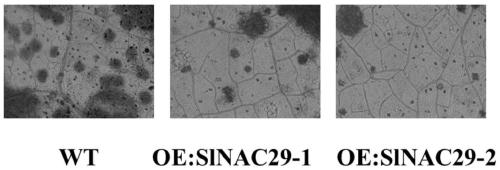Application of slnac29 Gene in Improving Tomato Bacterial Leaf Spot Resistance and Drought Tolerance
A technology for bacterial and leaf spot diseases, applied in the fields of application, genetic engineering, plant genetic improvement, etc., can solve the problems that tomato SlNAC29 gene research has not been reported, and achieve the effect of strong drought tolerance
- Summary
- Abstract
- Description
- Claims
- Application Information
AI Technical Summary
Problems solved by technology
Method used
Image
Examples
Embodiment 1
[0043] Cloning and Vector Construction of Example 1 Tomato SlNAC29 Gene
[0044] 1. Tomato Total RNA Extraction
[0045] Adopt Tiangen Plant total RNA extraction kit to extract the total RNA of young tomato leaves, the steps are:
[0046] (1) Take 0.1g of leaves and grind them in liquid nitrogen, add 1mL of lysate, and then use a homogenizer (specification model: Shanghai Jingxin JX-FSTPRP-48) to process;
[0047] (2) Place the homogenized sample at 15-30°C for 5 minutes to completely separate the nucleic acid-protein complex;
[0048] (3) Centrifuge at 12,000 rpm for 5 minutes at 4°C, remove the supernatant, and transfer to a new RNase-free centrifuge tube;
[0049] (4) Add 200 μL of chloroform, cover the tube cap, shake vigorously for 15 seconds, and place at room temperature for 3 minutes;
[0050] (5) 4°C, 12000rpm centrifuge for 10min, the sample will be divided into three layers: yellow organic phase, intermediate layer and colorless water phase, RNA is mainly in the ...
Embodiment 2
[0062] Embodiment 2 constructs the overexpression plant of tomato SlNAC29 gene
[0063] 1. Cultivate sterile vaccines
[0064] Tomato seeds (Solanum lycopersicum Mill.cv.Condine Red) were shaken at 28°C and 200rpm for 6-8h with a shaker, then sterilized with 75% alcohol for 30sec, discarded the alcohol and sterilized in 10% NaClO for 15min (use a shaker at 28°C , 200rpm), washed with sterilized distilled water for 3 times and transferred to a sterilized container, inoculated in 1 / 2MS medium. Cultivate in the dark at 25°C until germination, and then transfer to a light cultivation room. The seedling growth conditions are 25°C, 16h light / 8h dark, and light intensity 1800lx.
[0065] 2. Prepare explants and culture Agrobacterium
[0066] 6 days after the seeds germinated, the cotyledons of the sterile seedlings were cut into a size of about 2-3 cm in length with a knife, and placed in the nursing medium KCMS for pre-cultivation for 1 day (protected from light, overnight). On t...
Embodiment 3
[0075] Embodiment 3 Bacterial leaf spot pathogenic bacteria processing
[0076] The tomato SlNAC29 overexpression plants prepared in Example 2 were inoculated with bacterial leaf spot pathogens.
[0077] Bacterial leaf spot pathogenic bacteria were inoculated in solid King's B medium containing 25mg / L rifampicin (peptone 10g, K 2 HPO 4 1.5g, glycerol 15ml, agar 15g, H 2O 1L, pH 7.0), it was activated after being cultured in a 28°C incubator for 2 days, transferred to the plate for one day, and treated with 10mM MgCl 2 Resuspend the bacteria in the solution, adjust the bacterial concentration to OD600=0.1, add 0.02% organic silicon, and spray on the back of tomato plant leaves, so that the bacterial liquid can infiltrate the leaves, and the bacterial suspension enters the intercellular space through the stomata.
[0078] Observe the blade morbidity situation after 3 days, according to figure 2 , 3 , it can be known that compared with the wild type, the disease index and ...
PUM
 Login to View More
Login to View More Abstract
Description
Claims
Application Information
 Login to View More
Login to View More - R&D
- Intellectual Property
- Life Sciences
- Materials
- Tech Scout
- Unparalleled Data Quality
- Higher Quality Content
- 60% Fewer Hallucinations
Browse by: Latest US Patents, China's latest patents, Technical Efficacy Thesaurus, Application Domain, Technology Topic, Popular Technical Reports.
© 2025 PatSnap. All rights reserved.Legal|Privacy policy|Modern Slavery Act Transparency Statement|Sitemap|About US| Contact US: help@patsnap.com



